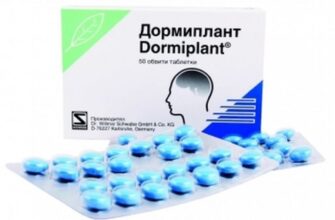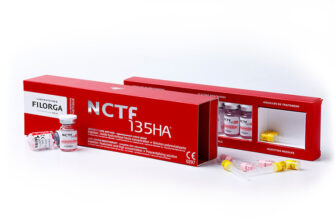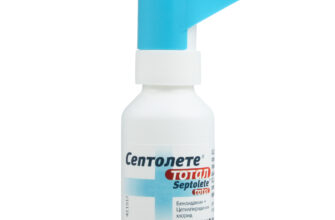Review of the best according to the editorial board. On the selection criteria. This material is subjective and does not constitute advertising and does not serve as a purchase guide. Before buying, you need to consult with a specialist.
'Love your bones' is the motto of the World Health Organization (WHO) for over 20 years now as World Osteoporosis Day, and our country has been participating in this initiative since 2005. According to research companies, the global market for osteoporosis drugs grows by 4% every year. Thus, in Russia, more than 14 million people suffer from various forms of osteoporosis.
In our country, drugs used to treat osteoporosis account for no more than 7% of all treatment costs, and the main costs are the treatment of fractures under compulsory medical insurance. As a rule, this price consists of being in a hospital and, and about 15% more are social benefits. This is a very bad indicator. Drugs for osteoporosis are known to prevent fractures and improve quality of life. If a person is admitted to the hospital with a fracture, it simply means that either the osteoporosis was not treated correctly, or he was not diagnosed. Let's deal with this important problem.
- What is osteoporosis
- Why does osteoporosis develop?
- How is osteoporosis treated?
- Overview of Osteoporosis Drugs
- Medications
- Why do you need calcium?
- Calcium and phosphorus are twin brothers
- Calcium magnesium chelate
- Calcium D3 Nycomed (calcium carbonate + cholecalciferol – vitamin D3)
- Rocaltrol
- 'Real' medicines
- Bisphosphonates
- Tevabon (alendronic acid)
- Bonviva (ibandronic acid)
- Risendros (risedronic acid)
- Aklasta, Resorba, Veroclast (zoledronic acid)
- Ossein-hydroxyapatites: Osteogenon
- Drugs affecting hormonal metabolism
- Tibolon (Livial)
- Raloxifene (Evista)
- Monoclonal antibodies: denosumab (Exjiva, Prolia)
- Teriparatid (Forsteo)
What is osteoporosis
Osteoporosis is a complex problem not only for endocrinology, gerontology, but also for internal diseases in general. Literally translated, the word 'osteoporosis' can be interpreted as excessive porosity, airiness of bone tissue. The main disadvantage of such a bone is a violation of its structure, a drop in the mass of the mineral substance of the bone tissue, and various defects as a result of excessive porosity.
It is known that bone, especially the end portions of long bones under high stress, are structured with optimal efficiency in terms of material strength. Everyone knows the photographs of the direction and intersection of the bone beams in the tibia, which resemble the vaults of Gothic temples. The location of the connective tissue base of inorganic calcium compounds (hydroxyapatite) on the beams gives the normal bone both elasticity, strength, hardness and resistance to fracture.
In the event of osteoporosis, imperfect deposition of calcium salts in the bones leads not only to high fragility of the bone matrix, but also sharply increases the risk of fractures for all sorts of trifles, and even for no reason at all. Sometimes enough for a fracture and just the mass of the limb without any load. Let's look at what the different types of osteoporosis are most often associated with.
Why does osteoporosis develop?
Of course, osteoporosis is best known in women who have reached the age of menopause. There is even a special, postmenopausal form of osteoporosis, which is rightly considered a female disease. Up to 80% of all forms of decrease in bone density fall on this particular form, and the blame is age and decreased ovarian function (non-modifiable risk factors).
In pre-menopausal women, estrogens protect bone tissue, and along the way, help a woman have fairly low levels of 'bad cholesterol'. That is why the cases of ischemic strokes in women aged 40 to 50 are so rare, and only then, after the onset of menopause, they are compared in the frequency of strokes with men. In men over the age of 40, the phenomenon of cardiovascular disasters, such as heart attack, stroke, is, unfortunately, not uncommon. Therefore, men 'take it out' on women over 50. A modern woman in her 50s has three times the risk of fracture than a typical man of her age. And osteoporosis is to blame for this. As a result, vertebral fractures occur, as well as a typical fracture of the radial bone in the distal section.
In old age, a special senile form of osteoporosis occurs, in which fractures of the femoral neck already occur, and the proximal parts of both the humerus and tibia. This occurs because senile osteoporosis is a condition in which the structure and density of several types of bone tissue is disrupted, in contrast to menopausal osteoporosis. There are also secondary forms of osteoporosis, which, of course, are associated with the pathology of the endocrine and nervous systems.
Here are some well-known diseases that can result in osteoporosis. These are hyperfunction of the adrenal cortex, or Itsenko-Cushing's disease, hyperfunction of the parathyroid glands, thyrotoxicosis, type 1 diabetes, rheumatism and rheumatoid arthritis, systemic lupus erythematosus and ankylosing spondylitis.
Clinically significant forms of osteoporosis occur as a result of operations on the stomach, which are accompanied by its resection, or removal of part of the organ. And the larger the volume of the resected tissue, the less calcium enters the bloodstream, and from there enters the bones. So calcium deficiency causes fractures.
The causes of osteoporosis include chronic liver and kidney failure, blood diseases such as thalassemia. Myeloma, a condition after removal of the ovaries in women and obstructive chronic processes in the lungs, long-term chronic alcoholism and osteogenesis imperfecta, some hereditary diseases, such as the Ehlers-Danlos syndrome 'rubber man', Marfan and Fanconi syndromes, leads to bone loss. Lead to a violation of bone density and an increased content of homocysteine, which is manifested by homocystinuria.
The correct diagnosis of osteoporosis is very important, and, unfortunately, very often they begin to look for its cause only after the appearance of diagnosed complications of osteoporosis – the presence of bone fractures that occurred either spontaneously or with very little physical impact. Therefore, in the event that you or your loved ones have the following complaints, then you need to start assessing the state of bone density. These are the 'red flags' that increase your risk of osteoporosis:
- various back pains that are not relieved by taking medication, associated with awkward movement or weight lifting;
- significant back fatigue after walking;
- the need to often lie down and rest during the day;
- the presence of vertebral body fractures;
- limb deformities;
- severe local pain in the bones when pressed.
Also very important risk factors are:
- deficiency of calcium and vitamin D, which can be determined in the laboratory;
- long-term use of corticosteroid hormones;
- chronic alcoholism and long-term smoking history;
- low physical activity and a long stay in a motionless state (immobilization after injuries);
- age over 65;
- being female, and an increased familial risk of osteoporosis.
In men, low testosterone levels can be considered an increased risk factor for deficiency in bone density.
How is osteoporosis treated?
Before prescribing drugs for osteoporosis of various types, it is necessary to accurately diagnose. Of course, it will be completely superfluous to prescribe expensive drugs for osteoporosis in the event that the patient has an alimentary calcium deficiency and vitamin deficiency of ergocalciferol, or vitamin D3.
First of all, it is necessary to make sure that the patient does not have a deficiency of calcium and vitamin D in the diet, that this calcium is absorbed, and its concentration in the blood is sufficient for normal osteogenesis, or the development of bone tissue. But these drugs will be discussed in the next section, and here I would like to list some non-drug methods of treatment and prevention of osteoporosis.
Thus, complete protein nutrition is extremely important, since protein is part of glycosaminoglycans – an organic part of normal bone tissue. And with a protein deficiency, it is impossible to build strong bone tissue.
The second very important point is a complete cessation of smoking and a sharp decrease in alcohol consumption. For the normal functioning of bones, their full blood supply, together with muscles and ligaments, is very important. This is facilitated by walking, swimming and various physical activities (water aerobics). It should be remembered that jumping, running and traumatic sports are categorically contraindicated.
As a means of treatment and prevention of vertebral fractures in osteoporosis, the wearing of semi-rigid corsets is indicated, but as short as possible. It has been proven that long and excessive abuse of corsets, the fear of being left without a corset, the habit to them causes reflex weakness of the back muscles, and, as a result, an increased risk of vertebral fractures.
Patients with severe forms of osteoporosis should not seek the services of a manual therapist, as their manipulation has been shown to increase the risk of vertebral fractures.
The patient must comply with a set of measures that is aimed at reducing the risk of falls and injury. This is the prevention and treatment of dizziness, fainting, prevention of progressive loss of vision. Timely treatment of cataracts and glaucoma in the elderly, complete vision correction is very important. An important factor is the availability of comfortable and stable shoes with a low heel. In winter, anti-icing couplings are very important, it is important not to neglect simple caution, and not to leave the house again unnecessarily in the presence of severe icy conditions.
Overview of Osteoporosis Drugs
| Nomination | a place | Name of product | price |
| Medications | 1 | Calcium magnesium chelate | RUB 1,840 |
| 2 | Calcium D3 Nycomed (calcium carbonate + cholecalciferol – vitamin D3) | 448 r | |
| 3 | Rocaltrol | 662 RUB | |
| Bisphosphonates | 1 | Tevabon (alendronic acid) | 844 RUB |
| 2 | Bonviva (ibandronic acid) | RUB 1,383 | |
| 3 | Risendros (risedronic acid) | RUB 2,004 | |
| 4 | Aklasta, Resorba, Veroclast (zoledronic acid) | RUB 17 638 | |
| OSSEIN HYDROXYAPATITES | 1 | Ossein-hydroxyapatites: Osteogenon | RUB 613 |
| Drugs affecting hormonal metabolism | 1 | Tibolon (Livial) | 2 435 RUB |
| 2 | Raloxifene (Evista) | – | |
| Monoclonal antibodies: denosumab (Exjiva, Prolia) | 1 | Teriparatid (Forsteo) | RUB 26,990 |
Medications
Now you can move on to drugs, and the first of them will be calcium and vitamin D3 preparations, which are over-the-counter, and belong to food supplements and vitamin-mineral complexes. They may well be prescribed to healthy people during critical periods of increased calcium intake, for example, during pregnancy. But first, let's recall a little about calcium metabolism.
Why do you need calcium?
First of all, muscle contraction is impossible without calcium. Not a single muscle fiber will contract without the involvement of ionized calcium in the process, including the myocardium. This means that life and movement are impossible without calcium.
Calcium is of paramount importance in the mechanisms of normal blood coagulation, without calcium it is impossible to convert prothrombin to thrombin, it is impossible to form a blood clot and fibrin to stop bleeding.
Still, almost 99% of calcium in bound form (in the form of hydroxyapatite) is actually found in bones and teeth. Circulates in the blood about 1% of all calcium. In turn, 50% of this part is ionized calcium, that is, a free, active form with a valence of 2+. And the remaining tiny part (0.5%) is associated with various proteins and acidic residues. This part can also be called calcium salts. These are lactic acid salt (lactate), calcium bicarbonate, phosphate and citrate. The ionized part of blood calcium is called free, and only it can be taken into account, since it is used by the body for various purposes.
After being circulated in the body, calcium is lost, leaving our body through the kidneys with urine. In order for an adult to maintain equality between calcium intake and its withdrawal from the body, approximately in terms of mineral matter, an average of one gram of calcium is needed every day. For these purposes, in addition to a full diet, in some cases, the use of tablets containing calcium is required.
Calcium and phosphorus are twin brothers
However, everything is not so simple: calcium metabolism is very strongly interconnected with phosphorus metabolism. There is even a concept of phosphorus-calcium metabolism. Phosphorus and calcium regulate each other through a negative feedback mechanism. The higher the concentration of calcium in the blood, the less phosphate, and vice versa.
This mechanism is regulated by the parathyroid (parathyroid) glands as well as the thyroid gland. The processes are as follows:
- when the level of calcium in the blood is low, the parathyroid glands 'feel' it. They release parathyroid hormone into the blood, and it 'requires' the activation of the work of those very special cells of bone tissue – osteoclasts – bone crushers, and the bone tissue is intensively destroyed by them. As a result, blood calcium levels rise, but there is also an increased risk of osteoporosis;
- if, on the contrary, the concentration of calcium in the blood is too high, then the thyroid gland already reacts. It secretes calcitonin into the blood, and vice versa, stimulates the formation of bone tissue. Calcium leaves the blood and rushes to the bones.
In addition, the active form of vitamin D plays a great role in the metabolism of calcium, and, consequently, phosphorus. It is with the help of vitamin D that the absorption of calcium from food in the gastrointestinal tract increases, and vitamin D helps to absorb calcium back from the primary urine and not to waste this useful ion.
Therefore, when answering the question, which is the best calcium tablets, one should take into account the content of phosphates, as well as vitamin D. The best calcium in tablets will never be 'just calcium'. For example, in the Soviet Union, children were fed with calcium gluconate for preventive purposes, but there were no vitamins, phosphates, or any other ingredients. Taking vitamin D was a pain, you had to swallow fish oil. The modern pharmaceutical industry produces a large number of vitamins and mineral complexes, as well as calcium tablets. Let's list the most useful and active ones.
Calcium magnesium chelate
Popularity rating: 4.9

The list of drugs for increasing calcium is opened by the imported American drug Calcium-magnesium chelate. It is so named because chelated compounds of calcium and magnesium, from the point of view of chemistry, have a special structure. These are complex compounds. Metal ions, in this case calcium and magnesium, are called a complexing agent, and around it are coordinated additional molecular units called ligands.
Chelated compounds are often used in medicine just for the introduction of various trace elements into the body. The complexes are very well absorbed in comparison with metal salts, for example, the rather ancient calcium gluconate.
In addition to chelated complexes of calcium and magnesium, the drug contains phosphorus, vitamin D3, and as a source of biologically active fiber – 2 milligrams of alfalfa per capsule.
The drug is sold in capsules, 150 pcs. in a bottle, produced by Natures Sunshine Products, USA, and the cost of a bottle is 1633 rubles. You need to take this drug one capsule 2 times a day, respectively, it will last for 75 days of taking, more than 2 months. Accordingly, the cost of a monthly admission fluctuates on average about 750 rubles.
The advantage can be considered the easiest assimilation by the body, and the disadvantage is a rather high price and it is not always possible to purchase it in pharmacies.
Calcium D3 Nycomed (calcium carbonate + cholecalciferol – vitamin D3)
Popularity rating: 4.8
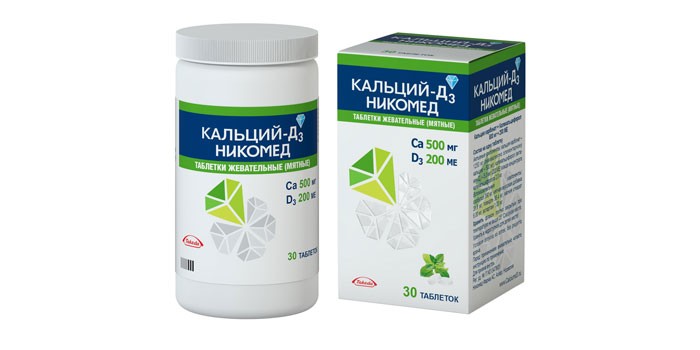
The next popular calcium tablet is Calcium D3 Nycomed. Despite the fact that it contains calcium in an inorganic form, that is, in the form of carbonate or a compound of calcium with weak carbonic acid, the tablets contain vitamin D3, which regulates the exchange of calcium and phosphorus. The tablets are available in orange and mint flavors and are chewable tablets. In terms of elemental calcium, each tablet contains 500 mg.
Therefore, for adults, 1 tablet 2 times a day is indicated for prevention. In pregnant women, as well as in patients at high risk of osteoporosis, the dose may be increased. Tablets should not be used in children under 3 years old, since they can simply choke on them, therefore, other drugs must be used to prevent rickets. So, it can be Aquadetrim drops, containing vitamin D, and other means.
The drug is produced by the Takeda company, and one pack of 60 chewable tablets, designed for a monthly course, costs only 330 rubles. This is more than half the price of the previous drug.
Rocaltrol
Popularity rating: 4.7
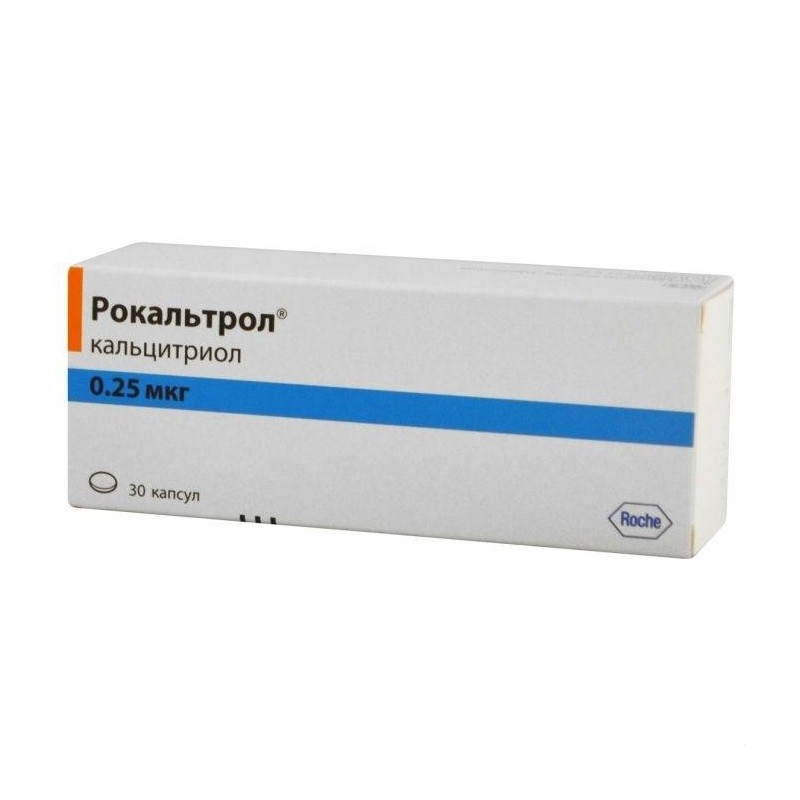
The German drug Rocaltrol continues the list of calcium preparations. Its main active ingredient is calcitriol. This is a special kind of vitamin D3, the active form. Its task is to improve the intake of calcium from food into the body, it increases its absorption. In addition, this compound reduces the secretion of calcium into the urine and allows it to be stored in the body. Calcitriol also helps to reduce the secretion of hormones from the parathyroid glands, this is another mechanism for maintaining calcium in the blood plasma.
Interestingly, the formula of this substance does not contain calcium, and, strictly speaking, this is not a mineral supplement, but a real drug for increasing blood plasma calcium, which does not contain this element itself. Rocaltrol is also an expensive remedy, and one package of 250 mg No. 30 capsules, designed for a monthly intake, costs, on average, 650 rubles at retail.
'Real' medicines
Of course, there are a very large number of calcium preparations. But their reception allows you to make up for an already existing deficit, or to prevent a deficiency of calcium and phosphorus. And if everything is fine with this level of mineral metabolism, but at the same time the patient still has diagnosed osteoporosis, what drugs are he using in modern medicine? Let's move on to medicines.
Improving the quality of life in the elderly with osteoporosis, and especially the prevention of fractures, are costly items. Therefore, knowing how the elderly are treated for osteoporosis, one can judge the welfare of the population in the country. If the country does not have such a problem as osteoporosis, then this does not mean at all about its high level of medicine. It's just that most people, for example, die young from infections and malnutrition.
Which patients need serious osteoporosis treatment? First of all, this is a woman after reaching the period of menopause, men over 50 years old who have spontaneous fractures or are caused by minimal trauma, including vertebral fractures, which are detected by chance. These are densitometry data (determination of bone density), osteopenia, and the corresponding laboratory criteria. The main purpose of using all the drugs described below for osteoporosis is to reduce and eliminate the risk of spontaneous fractures of bone tissue, that is, to eliminate the complications of osteoporosis.
For the treatment of various forms of osteoporosis, the following are used:
- various forms of bisphosphonates;
- monoclonal antibodies;
- organic strontium salts;
- hormonal agents and receptor agonists.
Also, according to indications, integrin antagonists, preparations of ossein-hydroxyapatite compounds, anabolic steroids, ipriflavone and other agents can be used. Let's consider some of them with proven effectiveness.
Bisphosphonates
It is known that healthy bone tissue consists of mature cells – osteocytes, young and immature osteoblast cells, and osteoclast cells. The latter destroy the used bone tissue, and often their excessive activity leads to the appearance of symptoms of osteoporosis. The first group of serious drugs that can reduce the symptoms of this serious illness and improve the quality of life are bisphosphonates.
Their role is to shorten the life span of osteoclasts, or induce their apoptosis. Accordingly, the amount of bone destroyed by osteoclasts, or resorbed bone tissue, decreases, and the balance shifts towards the newly formed bone mass. Simply put, drugs from this group do not promote renewal, but reduce bone breakdown. And the first of the bisphosphonates, which is the most inexpensive, will be Tevabon.
Tevabon (alendronic acid)
Popularity rating: 4.9

He, in addition to the precursor calcitriol, known to us, contains separately aledronic acid. This is a special compound that prevents the destruction of bone tissue, affecting osteoclasts, and already belongs exclusively to the drugs for the treatment of osteoporosis. Aledronic acid prevents the destruction of bones, helps to increase their strength, and this drug should be prescribed by a doctor, because there is a risk of adverse reactions.
Tevabon is a drug that is sold in two dosage forms at once: tablets and capsules. The tablets contain aledronic acid (70 mg per tablet) and should be taken orally once a week on an empty stomach before breakfast. Therefore, there are significantly fewer tablets than capsules. The capsules contain alfacalcidol, and it must be used one capsule per day in the evening every day.
So, a set of 28 capsules of alfacalcidol and 4 tablets of aledronic acid, calculated for a month of use, will cost 1200 rubles. The drug is produced by the Israeli company Teva, and it has the highest monthly cost of treatment (of all the funds listed above). But, since this is a special drug, and not a vitamin or supplement, then it stands 'apart', and this fact can be disregarded. The drug has many side effects: headache, insomnia, anemia, changes in blood pressure, abdominal pain, dry mouth, and so on. Tevabon is not intended for prevention, but only for treatment, and under the supervision of a physician.
Bonviva (ibandronic acid)
Popularity rating: 4.8
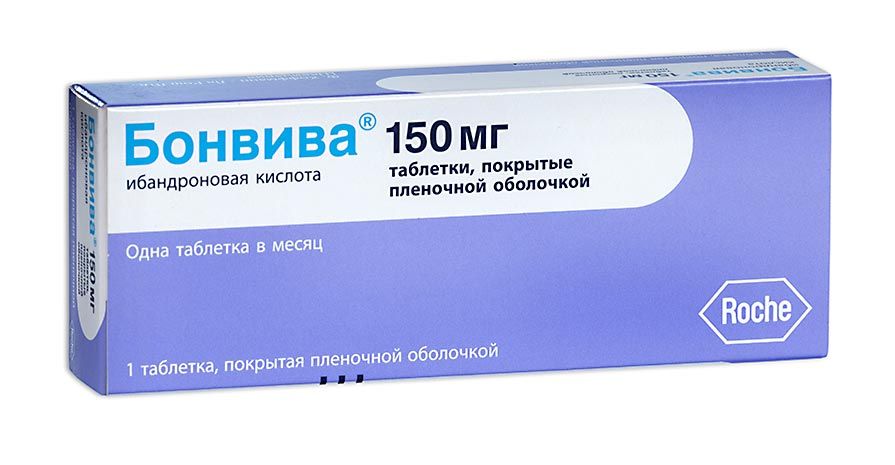
Bonviva is ibandronic acid, which is also classified as a bone resorption inhibitor. One tablet of the drug contains 150 mg of this acid in the form of sodium salt, the agent is intended for the treatment of postmenopausal osteoporosis.
Also, ibandronic acid is produced in syringes, in an amount of 3 mg of active ingredient in 3 ml. One 3 ml syringe, ready to use, equipped and filled, will cost, on average, from 3900 to 4350 rubles. The Romanian company Rompharm produces ibandronic acid in ampoules, this medicine is called Vivanat.
Bonviva is a tablet form of release, and it is produced by the Swiss company hoffmann La Roche. The cost of the drug is from 800 rubles to 1900 rubles. in pharmacies of different forms of ownership for the end of August 2019. It is important to understand that there is only one tablet in the package, and one tablet costs about 2,000 rubles. The only thing that saves Russian patients is that this pill is used internally only once a month, and the intravenous administration of Vivanat occurs only once every 3 months. And only this allows you to somehow save. After all, the treatment of osteoporosis is mainly the lot of the elderly, retirees, and in our country, the vast majority are low-income people.
Such a high price is due to the good activity of ibandronic acid, and it cannot lead to an overdose, and does not affect the long-term change in the number of osteoclasts. The combination of a large therapeutic dose range with high potency allows physicians to use Bonviva in a flexible regimen, with different dosages, and is rarely used. The high efficacy of ibandronic acid is proved by the fact that after 3 years of treatment, the bone structure in women during menopause did not differ from that of healthy women.
Ibandronic acid is indicated primarily for the treatment of women with postmenopausal osteoporosis. However, when using all drugs from this group without exception, you first need to make sure that the patient does not have a calcium deficiency. Hypocalcemia is a contraindication to treatment, and its fact when prescribing bisphosphonates is a gross miscalculation, an expensive diagnostic error. Bonviva is not indicated also during pregnancy, during breastfeeding, for persons under the age of 18, if there is a severe impairment of renal function. There are many side effects that will not be described here. It is the task of the attending physician – to explain everything to the patient before prescribing the drug, and monitor side effects, fight them. The medicine can also interact with other drugs.
Risendros (risedronic acid)
Popularity rating: 4.7
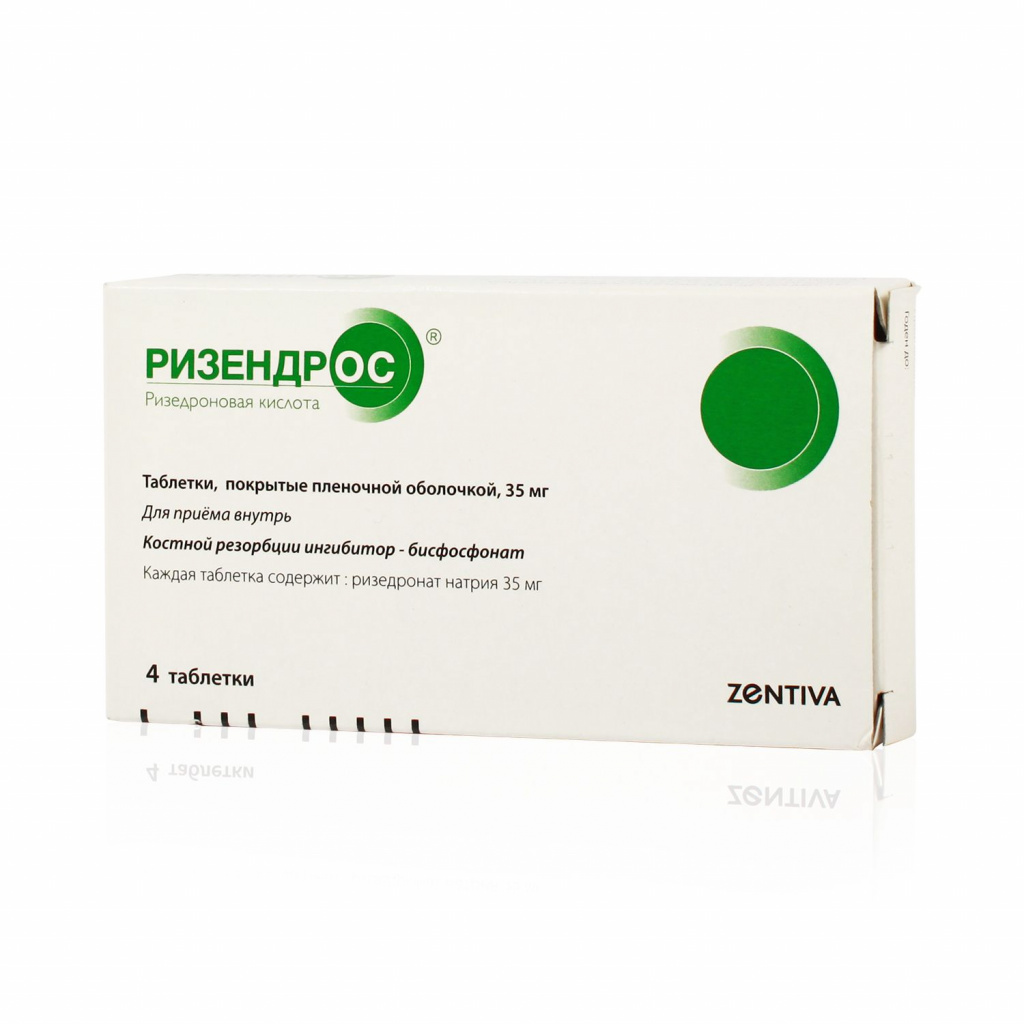
This drug is manufactured by Zentiva in the Czech Republic. One tablet contains 35 mg of sodium risedronate. The action of the drug is also associated with the suppression of the functions of osteoclasts, active risedronic acid binds to hydroxyapatites. It is necessary to treat the patient for a long time, and the maximum therapeutic effect develops in six months, and this medicine works for another six months due to a kind of cumulation. The tablet is taken by mouth, once a week, and Rizendros is indicated not only for the treatment of postmenopausal osteoporosis in women, but also for the treatment of bone density deficiency associated with long-term use of corticosteroid hormones.
Therefore, this medicine can be used not only in women, but also in men. It is important that the pill must be taken exactly on the same day of the week. The drug is contraindicated, in the same way, with a low level of calcium, severe decrease in the filtration capacity of the kidneys, in case of pregnancy, breastfeeding, and in children.
It should be said that, of course, pregnancy is the ability of a fertile, that is, a healthy woman to bear children in the 'process itself'. But menopause, in which osteoporosis develops, is age-related hypofunction of the ovaries, when they cease to secrete the required amount of estrogen. Therefore, the states of pregnancy and menopause are opposite, and cannot fit in the same woman at the same time.
But since these drugs cause disorders in the development of bone tissue in embryos, manufacturers are simply obliged to indicate pregnancy and childhood as contraindications, although children even more cannot have age-related menopause, since it corresponds to the age of 50 years.
Although this drug is not cheap, it is not that expensive either. One pack of 12 tablets, designed for 3 months of admission, costs from 2400 to 3400 rubles at retail.
The advantage of this drug can be considered high activity and a rather rare schedule of appointments – once a week. Some consider this a plus, while others, more forgetful ones, a minus.
However, you must strictly follow the instructions. Patients may have dysfunction of the esophagus in the form of its erosive and ulcerative lesions and, especially in those individuals who have been diagnosed with esophageal strictures or achalasia of the cardia.
In addition, after taking the pill, the patient must be in an upright position for 30 minutes so that this acid can leave the esophagus as soon as possible, otherwise the use of the agent will be contraindicated. In case of an overdose of this remedy, a decrease in the level of calcium in the blood is possible, and the most common side effects are constipation, headache, pain in the muscles and eyes, hives and allergic reactions.
Aklasta, Resorba, Veroclast (zoledronic acid)
Popularity rating: 4.6
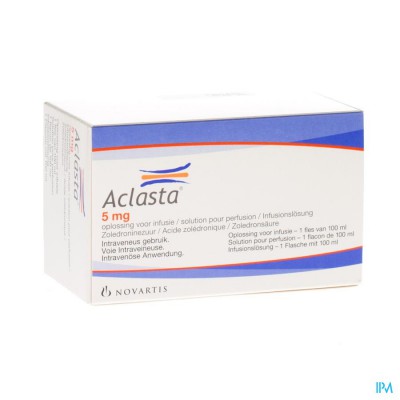
These osteoporosis medications are the “heavy artillery” of all bisphosphonates, and contain zoledronic acid. Aklasta is a highly selective drug that acts only on mineralized bone tissue, and its activity is due to the high affinity of the active substance for the active part of a special enzyme that is found in osteoclasts and is associated with their activity.
Therefore, zoledronic acid only reduces resorption. But the formation of bone, the effect on the degree of mineralization, as well as the mechanical properties of Aklasta are negligible. These properties of the bone remain unchanged, and this is very important.
The use of zoledronic acid in patients with osteoporosis, according to all the canons of evidence-based medicine and statistics, reduces the risk of fractures, for example, vertebrae – after 3 years of treatment by 70%, and this is a truly amazing result. It is necessary to use this remedy, in addition to menopausal osteoporosis, for the prevention of new fractures, if the patient already has a hip fracture.
Aklasta is prescribed for osteoporosis in men, for the prevention and treatment of hormonal forms of osteoporosis, as well as in the presence of Paget's disease, its bone form. Aklast's drug is dripped intravenously, in an amount of 100 ml. Accordingly, Aklasta also comes on sale in plastic bottles of this volume. At the same time, the cost of one bottle is quite high: from 16,500 to 20,000 rubles. On the other hand, this is the cost of an annual treatment, so the cost of a monthly treatment in case of minimum prices may even cost less than 1400 rubles.
The drug Aklasta is a highly effective medicine of European quality; it is produced by the Swiss company Fresenius and Novartis Pharma. This agent is also contraindicated, like other bisphosphonates during pregnancy, lactation, breastfeeding, with low plasma calcium concentration and with a pronounced decrease in the concentration of the kidneys, when creatinine clearance falls less than 30 ml per minute.
Aklasta can cause various side effects. These are short bouts of fever, muscle aches, flu-like syndrome, joint pain and headache. Usually, when prescribed correctly, these side effects last no longer than 3 to 5 days. In addition to treatment, Aklasta and analogs are also used to prevent postmenopausal osteoporosis, and then patients may have side effects such as anxiety and headache.
Ossein-hydroxyapatites: Osteogenon
Osteogenon already belongs to the classification of correctors of the exchange of cartilage and bone tissue, it contains calcium and phosphorus in the form of phosphate hydroxide, or in the form of hydroxyapatite. It is in this form that it is found in bone tissue. Also in the preparation there is ossein, or a special protein consisting of peptides. It reduces the destruction of bone tissue, and stimulates its reproduction, or osteogenesis. Thus, Osteogenon does not affect osteoclasts in any way, like bisphosphonates, but its task is to provide 'food' for osteoblasts. Therefore, it is indicated not only for the prevention of calcium deficiency, but also for various forms of osteoporosis: primary and secondary. For example, when a patient is treated with glucocorticosteroids for a long time. It is necessary to use Osteogenon for prophylaxis, two tablets per day, and for osteoporosis (as prescribed by a doctor) up to 8 tablets per day. Of course, there are contraindications, so this drug must be prescribed by a doctor.
Osteogenon also belongs to the high price range of calcium preparations, but compared to Aklasta, these are mere 'flowers'. A pack of 40 tablets, on average, costs 660 rubles. This is a French product from the Pierre Fabre company. One package will last for 20 days, and a monthly course with a preventive purpose will cost about 1000 rubles. However, despite its high cost, it is the only existing drug that belongs to the ossein-hydroxyapatite compound and is available in our country.
Drugs affecting hormonal metabolism
The appointment of these funds is the prerogative of either an andrologist or a gynecologist-endocrinologist. An increase or hormonal production of the ovaries, or an increase in the sensitivity of receptors to estrogen is almost always used in young people who have not yet reached menopause in terms of age, but already have a hormone deficiency associated with a lack of estrogen production. Consider just two drugs that are used in these categories.
Tibolon (Livial)
Popularity rating: 4.9
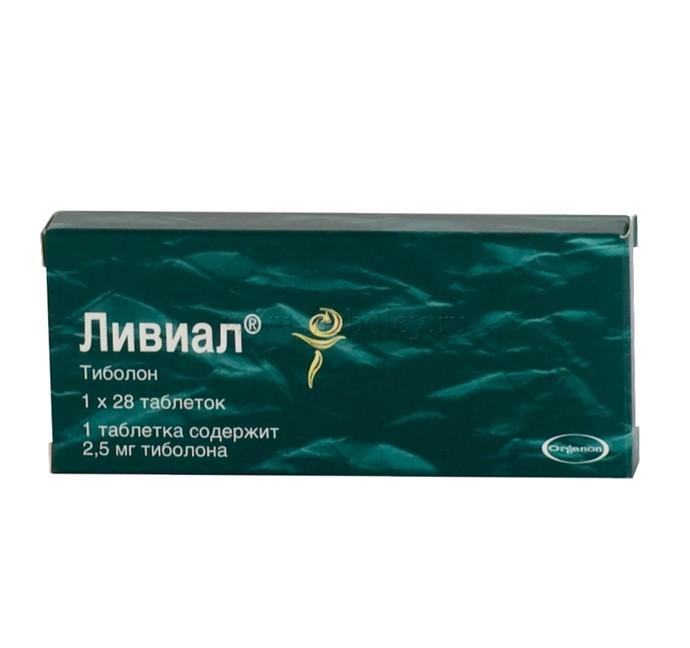
Livial is used for the successful treatment of menopausal syndrome, and against the background of treatment with this remedy, the resumption of regular bleeding, the so-called withdrawal bleeding, does not occur. The agent has a pronounced estrogenic and progesterone properties. This replacement of ovarian function is very useful in the presence of menopausal symptoms, as well as in the prevention of osteoporosis when there is laboratory-proven estrogen deficiency. Only a year after the end of the last natural menstruation can you begin treatment with this remedy. Otherwise, a side effect such as frequent bleeding is possible, and the shorter the period after the last menstrual period before starting treatment, the higher the risk. Livial is taken 1 tablet daily, there is a corresponding marking on the package, it shows on which day the drug should be used.
The drug is contraindicated in pregnant and lactating women, in the case of a hormone-dependent tumor, with a history of thrombosis, thrombotic conditions and thromboembolism, as well as in the presence of vaginal bleeding.
Livial has side effects such as pain in the lower abdomen and in the mammary glands, increased facial and body hair growth, weight gain, and vaginal discomfort. There are other side effects too, such as swelling, joint pain and depression. Therefore, a full examination is necessary before its appointment.
It is necessary to use Livial after the onset of the usual 'age-related' menopause only if the patient's symptoms are very painful to reduce the quality of life. The drug is produced by the pharmaceutical company Organon, the Netherlands. The cost of one package of 28 tablets, calculated for a monthly course, ranges from 2300 to 3400 rubles. The Spanish analogue of Welledien, produced by Leon Pharma, is several times cheaper: its price, on average, is 900 rubles for the same package.
Raloxifene (Evista)
Popularity rating: 4.8
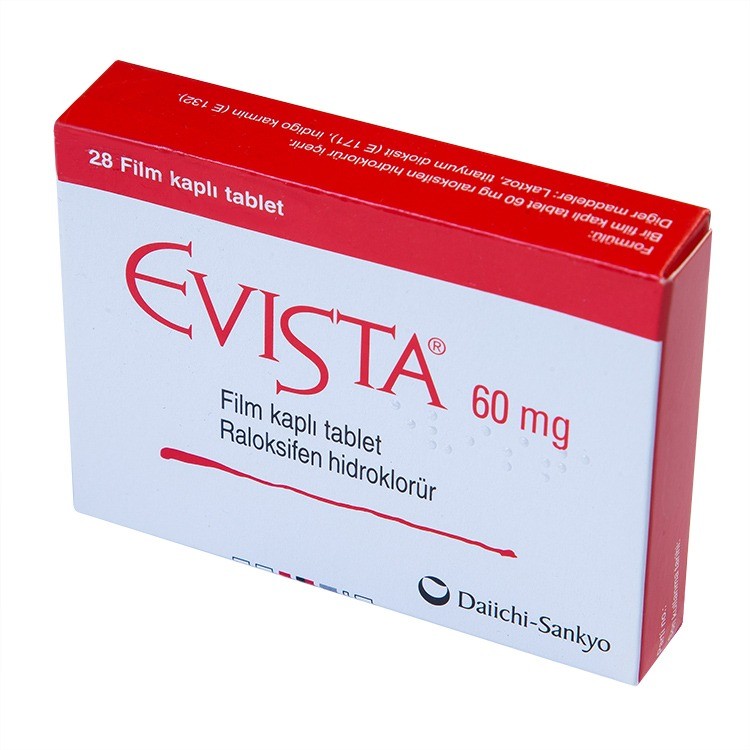
Evista, produced by the German company Daiichi Sankyo Europe GmbH. This is a different approach to hormone therapy. Drugs in this class do not increase the amount of hormones in a woman's body, they simply change the estrogen receptors in the body and increase their sensitivity. In this case, receptors associated with reproductive tissues, for example, with the epithelium of the uterus, are not only not activated, but also suppressed. And receptors for estrogen, which do not belong to the female genital area, are activated. This action on different receptors is called selective, or selective. Therefore, if Evista is used together with calcium preparations, then therapy with this drug leads to an increase in bone density, primarily of the spine and femurs. This prevents the appearance of compression fractures of the vertebral bodies and the femoral neck.
Raloxifene is indicated for menopausal women as a means of preventing osteoporosis. It can also be applied after removal of the uterus. The second indication for the appointment is the prevention of unpleasant symptoms of menopause, as well as the prevention of the risk of developing breast cancer after the extinction of ovarian function in the presence of a high risk. In men, this remedy is used to treat gynecomastia, and since this drug is an anti-estrogenic drug, it is also in demand among bodybuilders – bodybuilders.
Raloxifene should be taken at 60 mg daily, 1 tablet daily. The duration of the course is determined by the doctor. The remedy is completely contraindicated for pregnant and lactating women, children, with a high risk of thrombosis in case of allergic reactions. When treating Evista, it cannot be combined with estrogen drugs, and side effects such as small cramps of the calf muscles, peripheral edema are possible. The cost of Evista is about 2,000 rubles. for a pack of 28 tablets, designed for a monthly course of use.
Monoclonal antibodies: denosumab (Exjiva, Prolia)
In the treatment of metabolic diseases, which include osteoporosis, synthetic monoclonal antibodies are considered one of the most effective drugs. They are used to treat severe forms of psoriasis, bronchial asthma, and malignant neoplasms. To create this tool that blocks an unnecessary substance, and approaches it, 'like a key to a lock', and multiply molecules in identical copies, not only the modern chemical industry is required, but also genetic engineering. Exjiva also belongs to such drugs. Its task is to stop the destruction of the affected areas of bone tissue.
Therefore, it is used not only in severe forms of osteoporosis, but also in malignant neoplasms of bones, for example, in osteosarcomas. Monoclonal antibodies block the synthesis of special substances that destroy bones. The effectiveness of this drug is 75%, that is, a clinically proven effect is manifested in three out of every four people, if the drug is prescribed and taken within one month, not less.
Exjiva is a solution for subcutaneous administration, and is available in vials. Each bottle contains 120 mg denosumab, 1.7 ml. This is the amount that should be introduced once a month.
The introduction of such a serious drug requires preliminary training of the patient and medical personnel, the injection is carried out in the shoulder, thigh or abdomen, always while taking calcium and vitamin D preparations.
The most common side effects can be hypocalcemia, a drop in plasma phosphate, hyperhidrosis (sweating), diarrhea, loosening and loss of teeth, up to osteonecrosis of the jaw. But, however, if the drug is prescribed according to indications and under control, then it is effective and prevents the development of complications from the bone tissue, including in osteoporosis. The cost of a pack of Exjiva, which contains three bottles, is 45,900 rubles, for a course of three months.
Teriparatid (Forsteo)
Popularity rating: 4.7
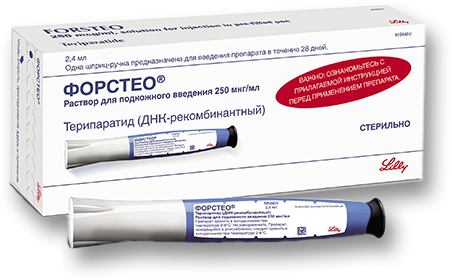
This drug belongs to analogs of the parathyroid hormone, also obtained by a recombinant method. For humans, it is produced by 'hand-held E. coli' living and 'working' in genetic engineering plants. This hormone stimulates the formation of bone tissue, directly affecting osteoblasts and increasing the uptake of calcium from the blood.
The introduction of teriparatide is required once a day, it has been proven to reduce the risk of complications of osteoporosis in its menopausal form. Forsteo is also used in primary forms of osteoporosis in men, which is caused by endocrine pathology – hypogonadism. It can also be used for steroidal forms of osteoporosis.
The agent is applied subcutaneously, injected into the thigh or abdomen, daily, 20 micrograms. Special patient training is required for self-injection. It is necessary to inform him about various side effects, which may include anemia, depression, dizziness and increased cholesterol levels, a drop in blood pressure and shortness of breath, and other symptoms. It must be remembered that the drug can interact with some other medications, so the treatment must be monitored by a doctor.
Teriparatide is sold in pharmacies, one syringe at a time. One syringe pen is not intended for one injection at all, but for using it for one month, more precisely, 28 days. The cost of one such syringe, that is, a monthly course, is on average 25,000 rubles, the Forsteo company Eli Lilly produces.
In conclusion, it should be recalled once again that osteoporosis in Russia is a very serious problem, especially in the context of a fall in the level of income of the population for the sixth year in a row. Now, almost 40 million people, or more than a quarter of the country's population, are at risk for osteoporotic fractures in our country, and the trend continues to increase. Treatment and rehabilitation of fractures is ultimately much more expensive than prevention, and especially in a non-drug way, based on the principles of a healthy lifestyle and proper nutrition.
The popularity rating is based on the analysis of demand data from the wordstat.yandex.ru service.
Attention! This rating is subjective and does not constitute an advertisement and does not serve as a purchase guide. Before buying, you need to consult with a specialist.



